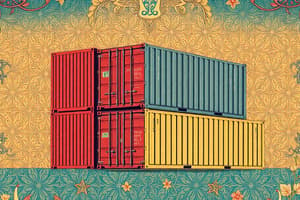Podcast
Questions and Answers
What is containerisation and how has it transformed cargo handling?
What is containerisation and how has it transformed cargo handling?
Containerisation is the use of standardized shipping containers to transport goods, which has transformed cargo handling by enabling efficient loading, unloading, and transport.
List two key features of containerisation that enhance its efficiency.
List two key features of containerisation that enhance its efficiency.
Two key features are standardization of container sizes and intermodal transport capabilities.
Explain how containerisation contributes to cost-effectiveness in shipping.
Explain how containerisation contributes to cost-effectiveness in shipping.
Containerisation lowers transportation costs due to economies of scale and reduced labor expenses during loading and unloading.
What challenges are associated with the initial implementation of containerisation?
What challenges are associated with the initial implementation of containerisation?
What is the significance of Malcolm McLean in the history of containerisation?
What is the significance of Malcolm McLean in the history of containerisation?
Identify and describe one type of container used in containerisation.
Identify and describe one type of container used in containerisation.
How has containerisation impacted global supply chains?
How has containerisation impacted global supply chains?
What role does security play in the benefits of containerisation?
What role does security play in the benefits of containerisation?
Discuss one negative consequence of containerisation related to piracy.
Discuss one negative consequence of containerisation related to piracy.
What impact has containerisation had on global trade volumes?
What impact has containerisation had on global trade volumes?
Flashcards are hidden until you start studying
Study Notes
Definition
- Containerisation refers to the use of standardized shipping containers for transporting goods.
- It revolutionized cargo handling and logistics by enabling efficient loading, unloading, and transport.
Key Features
- Standardization: Containers come in standard sizes, typically 20 or 40 feet long.
- Intermodal Transport: Containers can be easily transferred between ships, trucks, and trains without unloading cargo.
- Security: Containers provide a secure and weatherproof environment for goods.
Benefits
- Efficiency: Reduces loading and unloading times, speeding up shipping processes.
- Cost-Effective: Lower transportation costs due to economies of scale and reduced labor.
- Reduced Damage: Better protection of goods minimizes loss and damage during transit.
- Simplified Customs Procedures: Standardized containers streamline customs inspections and processing.
History
- 1950s: The modern container shipping system was developed, with Malcolm McLean being a key figure.
- 1970s: Widespread adoption as container ships became the dominant mode of international shipping.
Challenges
- Initial Investment: High costs associated with purchasing containers and upgrading ports.
- Infrastructure: Requires significant infrastructure for handling and transporting containers.
- Piracy and Theft: Increased risk of theft and piracy in certain regions due to the value of containerized cargo.
Types of Containers
- Dry Containers: Standard containers for general cargo.
- Reefer Containers: Temperature-controlled containers for perishable goods.
- Open Top Containers: For oversized cargo that cannot fit through standard doors.
- Flat Rack Containers: For heavy machinery and large items.
Impact on Global Trade
- Increased Trade Volume: Containerisation has significantly boosted global trade by making it more efficient.
- Global Supply Chains: Facilitated the development of complex supply chains that span multiple countries.
- Economic Growth: Contributed to economic growth in many regions by enhancing export capabilities.
Definition
- Containerisation utilizes standardized shipping containers, transforming cargo handling and logistics.
- It enables efficient processes for loading, unloading, and transporting goods across various modes of transport.
Key Features
- Standardization: Containers are available in common sizes of 20 or 40 feet, simplifying handling.
- Intermodal Transport: Containers seamlessly transfer between ships, trucks, and trains, enhancing flexibility.
- Security: Provides a weatherproof and secure environment, safeguarding goods during transit.
Benefits
- Efficiency: Dramatically reduces shipping times by expediting loading and unloading processes.
- Cost-Effective: Achieves lower transportation costs due to bulk movement and fewer labor requirements.
- Reduced Damage: Containers minimize loss and damage, leading to safer cargo transport.
- Simplified Customs Procedures: Standardized containers ease customs inspections and processing, speeding up trade.
History
- 1950s: Modern container shipping was pioneered, notably by Malcolm McLean, revolutionizing the industry.
- 1970s: Container ships gained dominance in international shipping due to broad acceptance.
Challenges
- Initial Investment: Significant upfront costs are required for purchasing containers and upgrading port facilities.
- Infrastructure: Effective container handling necessitates robust infrastructure at ports and transport networks.
- Piracy and Theft: The high value of containerized cargo increases the risk of theft and piracy in certain areas.
Types of Containers
- Dry Containers: Used for general cargo, these are the most common type.
- Reefer Containers: Equipped with refrigeration for transporting perishable goods.
- Open Top Containers: Designed for oversized cargo that cannot fit through standard container doors.
- Flat Rack Containers: Ideal for transporting heavy machinery and large items due to their open design.
Impact on Global Trade
- Increased Trade Volume: Containerisation has significantly enhanced global trade efficiency, leading to growth.
- Global Supply Chains: It has enabled the establishment of intricate supply chains that connect countries worldwide.
- Economic Growth: Boosted export capabilities, contributing positively to economic development in various regions.
Studying That Suits You
Use AI to generate personalized quizzes and flashcards to suit your learning preferences.




